Hassani S. Mathematical Physics: A Modern Introduction to Its Foundations
Подождите немного. Документ загружается.

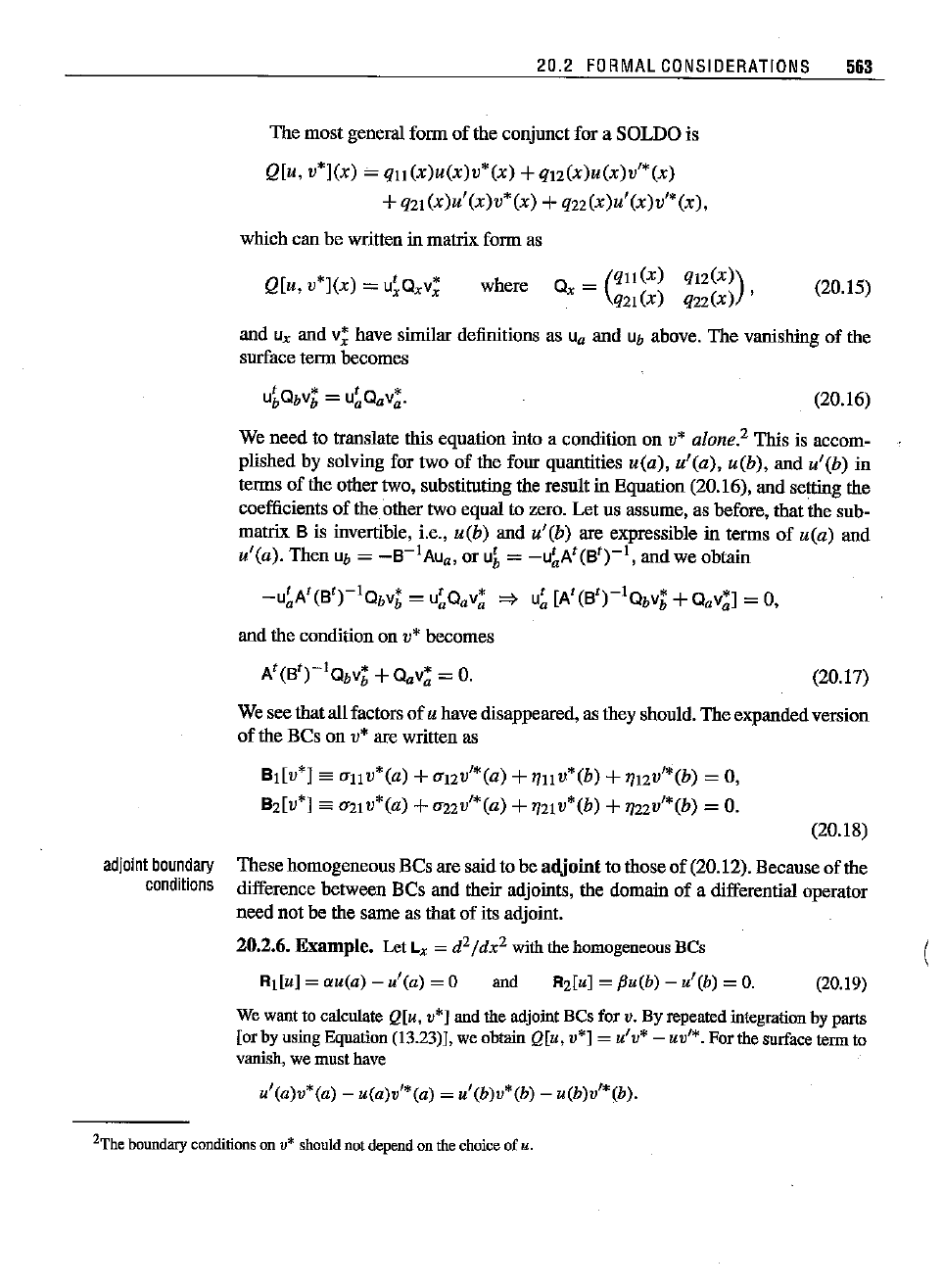
20.2
FORMAL
CONSIOERATIONS
563
The most general form
of
the conjnnct for a SOLDO is
Q[u,
v*](x)
'=
ql1
(x)u(x)v*(x)
+q12(X)U(X)v'*(x)
+
q21
(x)u'
(x)v*(x)
+q22(X)U'
(x)v'*(x),
which
can
he written in matrix form as
Q[u,
v*](x)
=
u~axv;
where
ax
=
(ql1
(x)
qJ2(X)),
Q21(X)
Q22(X)
(20.15)
and
U
x
and v; have similar definitions as U
a
and
Ub
ahove. The vanishing of the
surface
termbecomes
(20.16)
Weneed to
translate
this equation intoa conditionon v* alone/' This is accom-
plished hy solving for two
of
the four quantities
u(a),
u'(a),
u(b),
and
u'(b)
in
terms of the other two, suhstituting the result in Equation (20.16), and setting the
coefficients of the other two equal to zero. Let us assume, as before, that the suh-
matrix B is invertible, i.e.,
u(b)
and
u'(b)
are expressible in terms of u(a) and
u'(a).
Then
Ub
=
-B-1Au
a,
or ub
=
_u~At(Bt)-I,
and we obtain
-u~At(Bt)-labVb
=
u~aav~
=}
u~
[At
(Bt)-labVb
+aav~]
=0,
andtheconditionon v* becomes
(20.17)
We see that all factors
of
u have disappeared, as they should. The expandedversion
of the BCs on
v* are written as
BI[v*]
es
ul1v*(a)
+u12v'*(a) +
ql1v*(b)
+q12v'*(b) = 0,
B2[V*]
sa
u2Iv*(a)
+
U22
v'* (a) +Q2IV*(b) +Q22V'*(b) = O.
(20.18)
adjoint
boundary
These homogeneous BCs are said to be adjoint to those
of
(20.12). Because of the
conditions
difference between BCs and their adjoints, the domain of a differential operator
need not be the sarne as that of its adjoint.
20.2.6.
Example.
Let Lx = d
2
/
dx
2
withthehomogeneous BC,
RI[U] = au(a) - u'(a) = 0 and
R2[U]
=
f3u(b)
- u'(b) =
O.
(20.19)
Wewantto calculate
Q[u, v*] andthe adjointBC, for v. By repeatedintegration byparts
[or by using
Equation
(13.23)], we obtainQ[u, u"] = u'v* - uv'*. For the
surface
termto
vanish,
we musthave
u'(a)v*(a) - u(a)v'*(a) = u'(b)v*(b) - u(b)v'*(b).
2The
boundary
conditions
on v*
should
not
depend
onthechoiceof u.
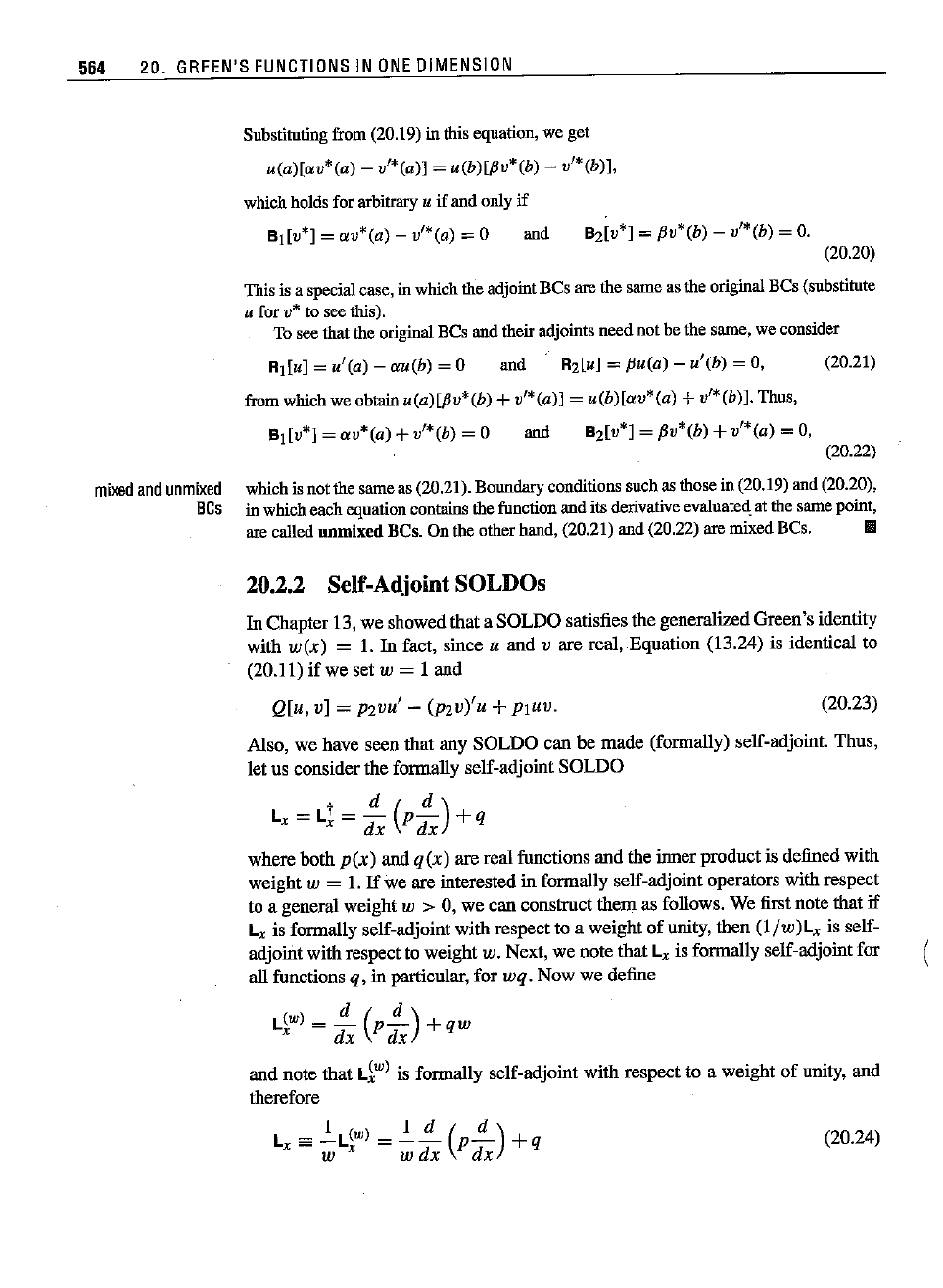
564 20.
GREEN'S
FUNCTIONS
IN
ONE
DIMENSION
B2[V*] ={lv*(b) - v'*(b) =O.
Substitutingfrom (20.19)in thisequation,we get
u(a)[av*(a)
- v'*(a)] =u(b)[{lv*(b) - v'*(b)],
whichholdsfor arbitraryu
if
andonly if
Bl[V*] =
av*(a)
- v'*(a) = 0 and
(20.20)
Thisisa
special
case,in whichthe
adjoint
Bes
arethesameasthe
original
Bes
(substitute
ufor v* to see this).
Tosee
that
the
original
Bes
and
their
adjoints
neednotbethe
same,
we
consider
Rdu]
=
u'(a)
-
au
(b) =0 and
R2[U]
={lu(a) -
u'(b)
=0, (20.21)
from whichwe obtain
u(a)[{lv*(b) +v'*(a)] =
u(b)[av*(a)
+v'*(b)]. Thus,
Bl[V*] =
av*(a)
+v'*(b) =0 and BZ[v*] ={lv*(b) +v'*(a) =0,
(20.22)
mixed
and
unmixed
whichisnotthe sameas(20.21).Boundaryconditionssuchasthosein (20.19)and(20.20),
BCs
inwhicheach
equation
contains
the
function
andits
derivative
evaluated:
atthesame
point,
arecalled unmixed BCs. Onthe otherhand, (20.21) and (20.22)aremixedBCs.
III
20.2.2 Self-AdjointSOLDOs
ill
Chapter 13, we showed that a
SOLDO
satisfies the generalized Green's identity
with
w(x)
= I.
ill
fact, since u and v are real, Eqnation (13.24) is identical to
(20.11) if we set
w = 1 and
Q[u, v] =
pzvu'
- (P2V)'U +
PIUV.
(20.23)
Also, we have seen that any
SOLDO
can be
made
(formally) self-adjoint. Thus,
let us considerthe formally self-adjoint
SOLDO
Lx =
L%
=
:x
(p
:x)
+q
where both
p(x)
and
q(x)
are real functions and the inner productis defined with
weight
w = I.
lf
we are interested in formally self-adjoint operators with respect
to a general weight
w > 0, we can construct
them
as follows. We first note that
if
Lx is formally self-adjoint with respect to a weight
of
unity, then
(l/w)L
x
is self-
adjoint withrespectto weight
w. Next, we note that Lx is formally self-adjointfor
all functions
q, in particular, for wq.
Now
we define
L(w) =
~
(p~)
+qw
x
dx
dx
and note that
Li
w
)
is formally self-adjoint
with
respect to a weight
of
unity, and
therefore
lw
ld(d)
Lx=-Li)=--
P-
+q
w
wdx
dx
(20.24)
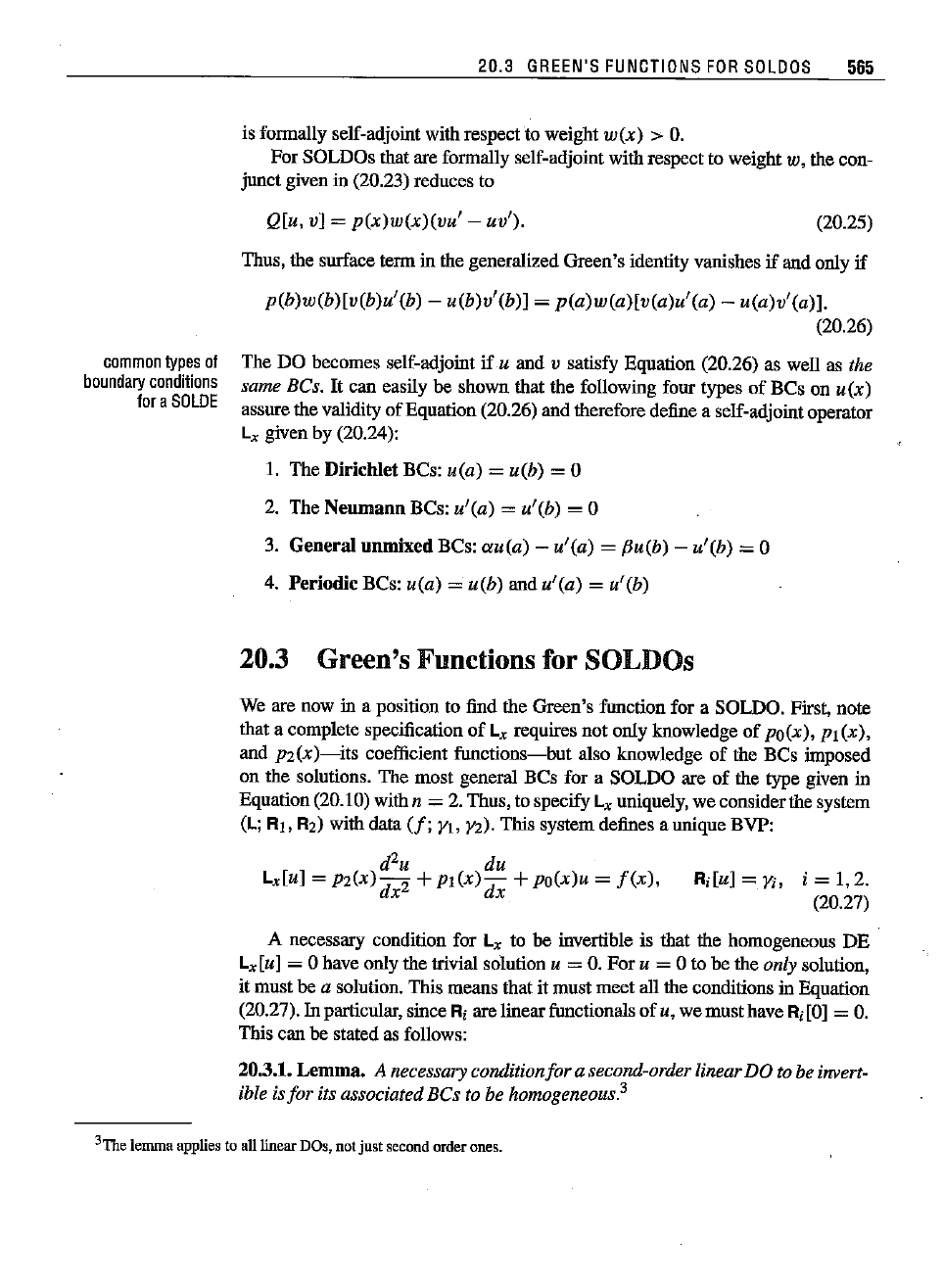
20.3
GREEN'S
FUNCTIONS
FOR
SOlDOS 565
is formally self-adjoint with respect to weight
w(x)
>
O.
For SOLDOs that are formally self-adjoint with respect to weight w, the con-
jnnct given in (20.23) reduces to
Q[u, v] =
p(x)w(x)(vu'
- uv'). (20.25)
Ri[U]
=Vi, i =
1,2.
(20.27)
common
types
of
boundary
conditions
fora
SOlDE
Thus, the surface term in the generalized Green's identity vanishes
if
and only if
p(b)w(b)[v(b)u'(b) -
u(b)v'
(b)] =
p(a)w(a)[v(a)u'
(a) -
u(a)v'
(a)].
(20.26)
The DO becomes self-adjoint if
u and v satisfy Equation (20.26) as well as the
same BCs.
It
can easily be shown that the following four types
of
BCs on
u(x)
assure the validity of Equation (20.26) and therefore define a self-adjoint operator
Lx given by (20.24):
I. The
Dirichlet
BCs: u(a) = u(b) =0
2. The
Neumann
BCs: u'(a) =u'(b) =0
3.
General
unmixed
BCs:
au(a)
- u'(a) =fJu(b) - u'(b) =0
4.
Periodic
BCs: u(a) =u(b) and u'(a) =u'(b)
20.3 Green's Functions for SOLDOs
We are now in a position to find the Green's function for a SOLDO. First, note
that a complete specification
of
Lx requires not only knowledge
of
po(x), Pt (x),
and
p2(x)-its
coefficient
functions-but
also knowledge
of
the BCs iroposed
on the solutions. The most general BCs for a SOLDO are of the type given in
Equation(20.10) with
n = 2. Thus, to specify Lxuniqnely, we considerthe system
(L; RI, R2) with data
(f;
VI,
)12).
This system defioes a unique BVP:
d
2u
du
Lx[u]
=P2(X)
dx
2
+PI(x)
dx
+
po(x)u
=
f(x),
A necessary condition for Lx to be invertible is that the homogeneous DE
Lx[u] = 0 have only the trivial solution u =
O.
For
u = 0 to be the only solntion,
it must be
a solntion. This means that it must meet all the conditions in Equation
(20.27).
In particular, since Ri are linearfunctionals of u, we musthave Ri[0] =
O.
This can be stated as follows:
20.3.1.
Lemma.
Anecessary condition
for
a second-order linearDO to be invert-
ible is
for
its associated BCs to be homogeneous?
3The lemma applies to all linear DOs, not
just
second order ones.
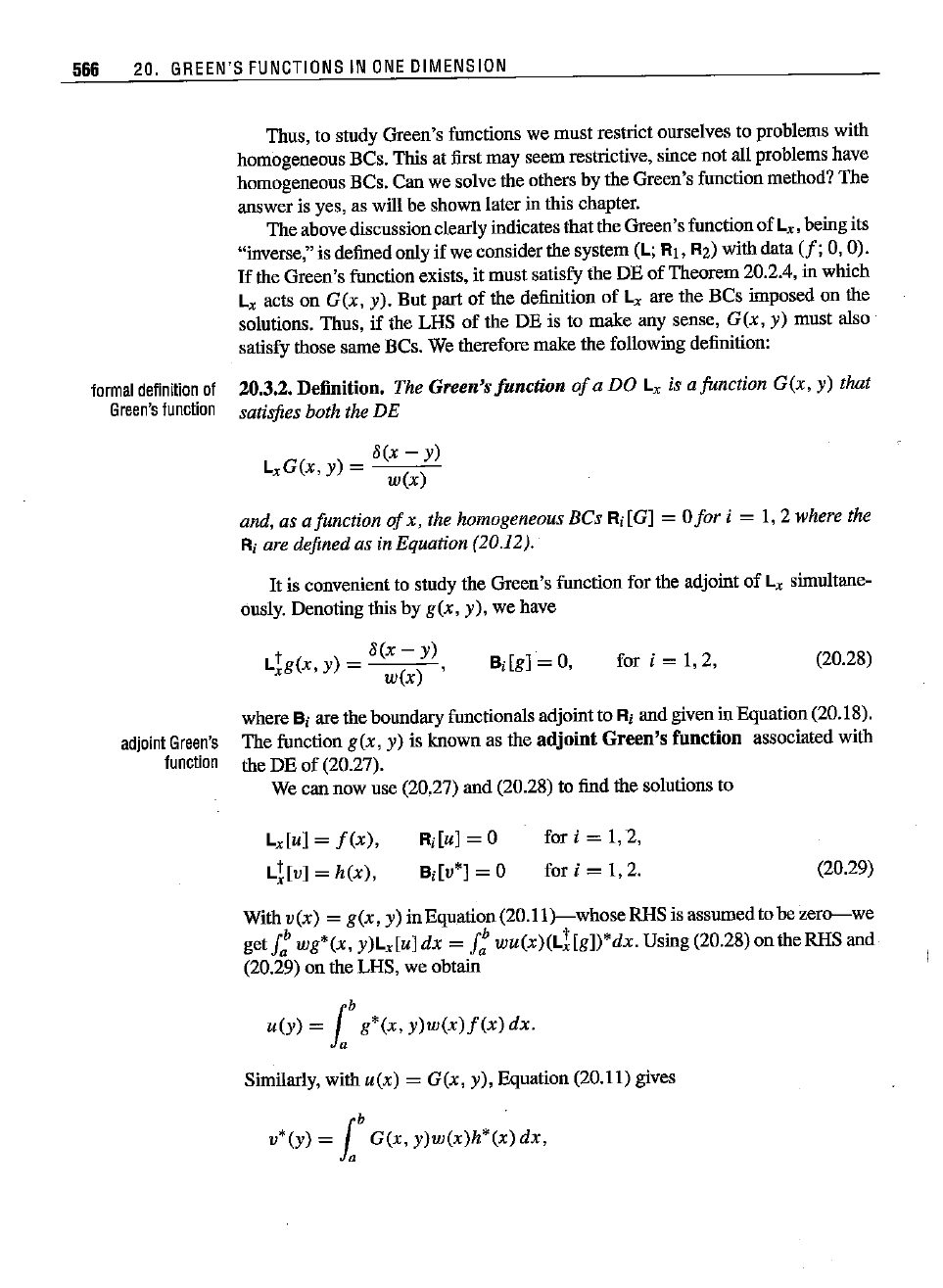
566 20.
GREEN'S
FUNCTIONS
IN
ONE
OIMENSION
Thus, to study Green's functions we must restrict ourselves to problems with
homogeneous BCs. This at first may seem restrictive, since not all problems have
homogeneons BCs. Can we solve the others by the Green's function method? The
answer is yes, as will be shown later in this chapter.
The above discussionclearly indicates that the Green'sfunction of
Lx>
being its
"inverse," is defined only if we considerthe system
(L;
Rj,
Rz) withdata
(I;
0, 0).
If
the Green's function exists, it must satisfy the DE
of
Theorem 20.2.4, in which
Lx acts on G(x, y).
But
part of the definition of Lx are the BCs imposed on the
solutions. Thus, if the LHS of the DE is to make any sense,
G(x,
y)
must also
satisfy those sarae BCs. We therefore make the following definition:
formal
definition
of 20.3.2. Definition. The Green's
function
of
a DO Lx is a function
G(x,
y) that
Green's
function
satisfies both the DE
8(x
- y)
LxG(x, y) =
w(x)
and, as afunction
of
x, the homogeneous
Bes
Ri[G] = Ofor i =
1,2
where the
Ri are defined as in Equation (20.12).
It
is convenient to study the Green's fumction for the adjoint of Lx simultane-
ously. Denoting this by
g(x,
y), we have
t
8(x
-
y)
Lxg(x, y) =
w(x)
,
Bi[g]
= 0, for i =
1,2,
(20.28)
where
Bi are the boundary fumctionalsadjointto Ri and given in Equation(20.18).
adjoint
Green's
The function
g(x,
y)
is known as the
adjoint
Green's
function
associated with
function
the DE
of
(20.27).
We
can
now use (20.27) and (20.28) to find the solutions to
Lx[u] =
f(x),
L1[v] = hex),
Ri[U]
= 0
Bi[V*]
= 0
for i =
1,2,
for i =
1,2.
(20.29)
With
v(x) =
g(x,
y) in Equation(20.11
)-whose
RHS is assumedto he
zero-we
getJ:
wg*(x, y)Lx[u]
dx
=
J:
wu(x)(d[gj)*dx.
Using (20.28) on the
RHSand
(20.29) on the LHS, we obtain
u(y)
= l
b
g*(x,
y)w(x)f(x)
dx.
Similarly, with
u(x)
=
G(x,
y), Equation (20.11) gives
v*(y) = l
b
G(x,
y)w(x)h*(x)
dx
;
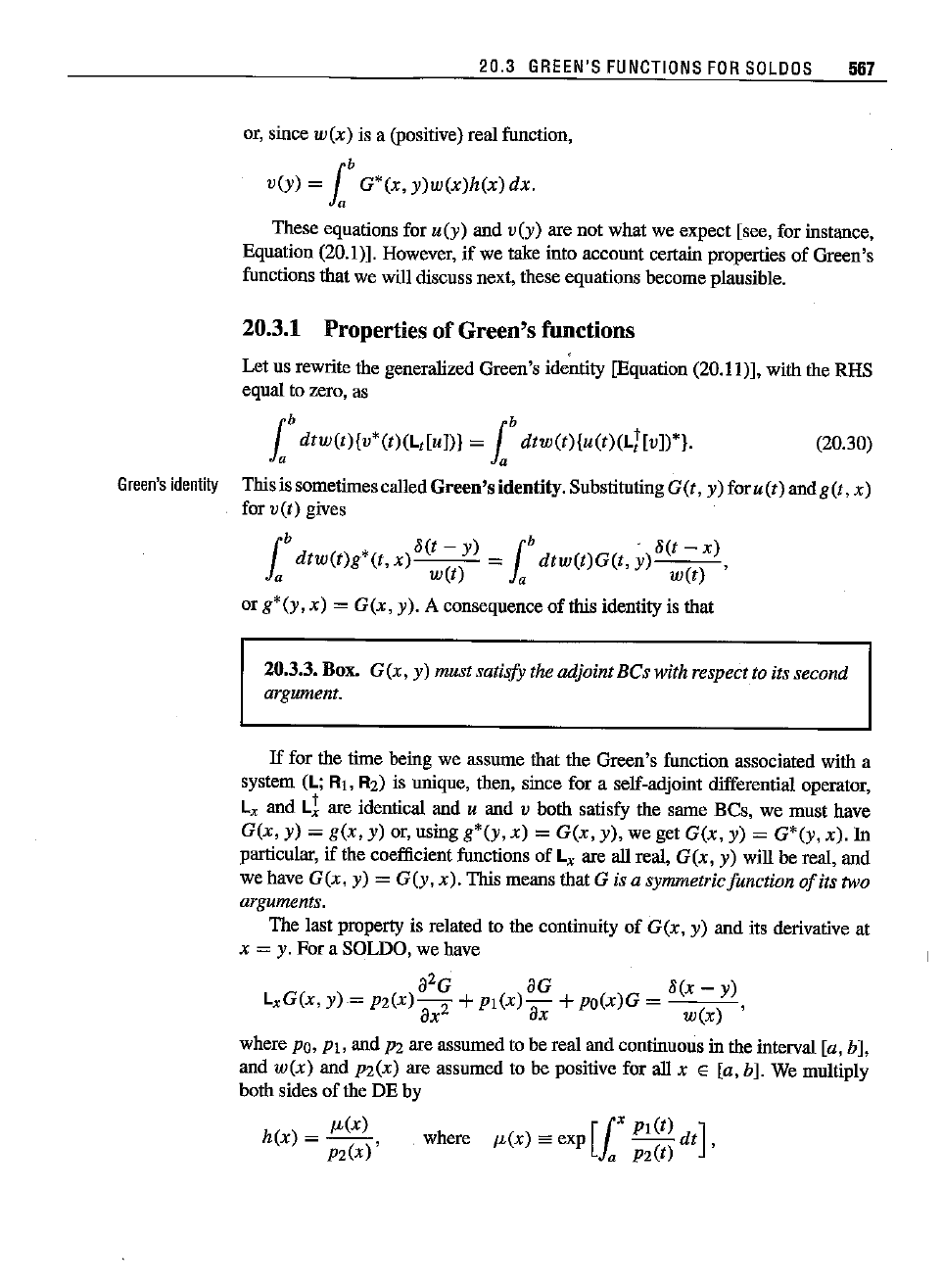
20.3
GREEN'S
FUNCTIONS
FOR
SOLO
OS
567
or, since w
(x)
is a (positive) real function,
v(y)
= 1
b
G*(x,
y)w(x)h(x)dx.
These equations for
u(y)
and
v(y)
are not what we expect [see, for instance,
Equatiou (20.1)]. However,
if
we take into account certain properties of Green's
functions that we will discuss next, these equations become plausible.
20.3.1 Properties of Green's functions
Let us rewrite the generalized Green's identity [Equation (20.11)], with the RHS
equaltozero,as
1
b
dtw(t){v*(t)(Lt[u]))
= 1
b
dtw(t){u(t)(L;[vj)*j.
(20.30)
Green's
identity
This is sometimes called
Green's
identity. Substituting
G(t,
y) for
u(t)
and
g(t,
x)
for vet) gives
1
b
8(t
y) 1
b
.
8(t
x)
dtw(t)g*(t,
x)
- =
dtw(t)G(t,
y) - ,
a wet) a wet)
or g*(y,
x)
=
G(x,
y). A consequence
of
this identity is that
20.3.3. Box.
G(x,
y) mustsatisfy the adjoint
Bes
with respect to its second
argument.
If
for the time being we assume that the Green's function associated with a
system
(L; RI, Rz) is unique, then, since for a self-adjoint differential operator,
Lx
and Ll are identical and u and v both satisfy the same BCs, we must have
G(x,
y) =
g(x,
y) or, using
g*(y,
x)
=
G(x,
y),
we get
G(x,
y) =
G*(y,
x).
In
particular,
if
the coefficient functions of Lx are all real, G(x, y) will be real, and
we have G(x,
y) = G(y,
x).
This means that G is a symmetricfunction
of
its two
arguments.
The last property is related to the continuity
of
G(x,
y) and its derivative at
x = y. For a SOLDO, we have
aZG
aG
8(x - y)
LxG(x,
y)=
pz(x)-z
+
PI(x)-a
+
po(x)G
=
()'
ax
x W x
where
PO,
PI,
and PZare assumed to be real and continuous in the interval [a, b],
and
w(x)
and
pz(x)
are assumed to be positive for all x E [a, b]. We multiply
both sides of the DE by
Jk(x)
[l
x
PI
(t)
]
hex)
=
--)'
where Jk(x)
'"
exp
-(-)
dt
,
pz(x
a PZ t
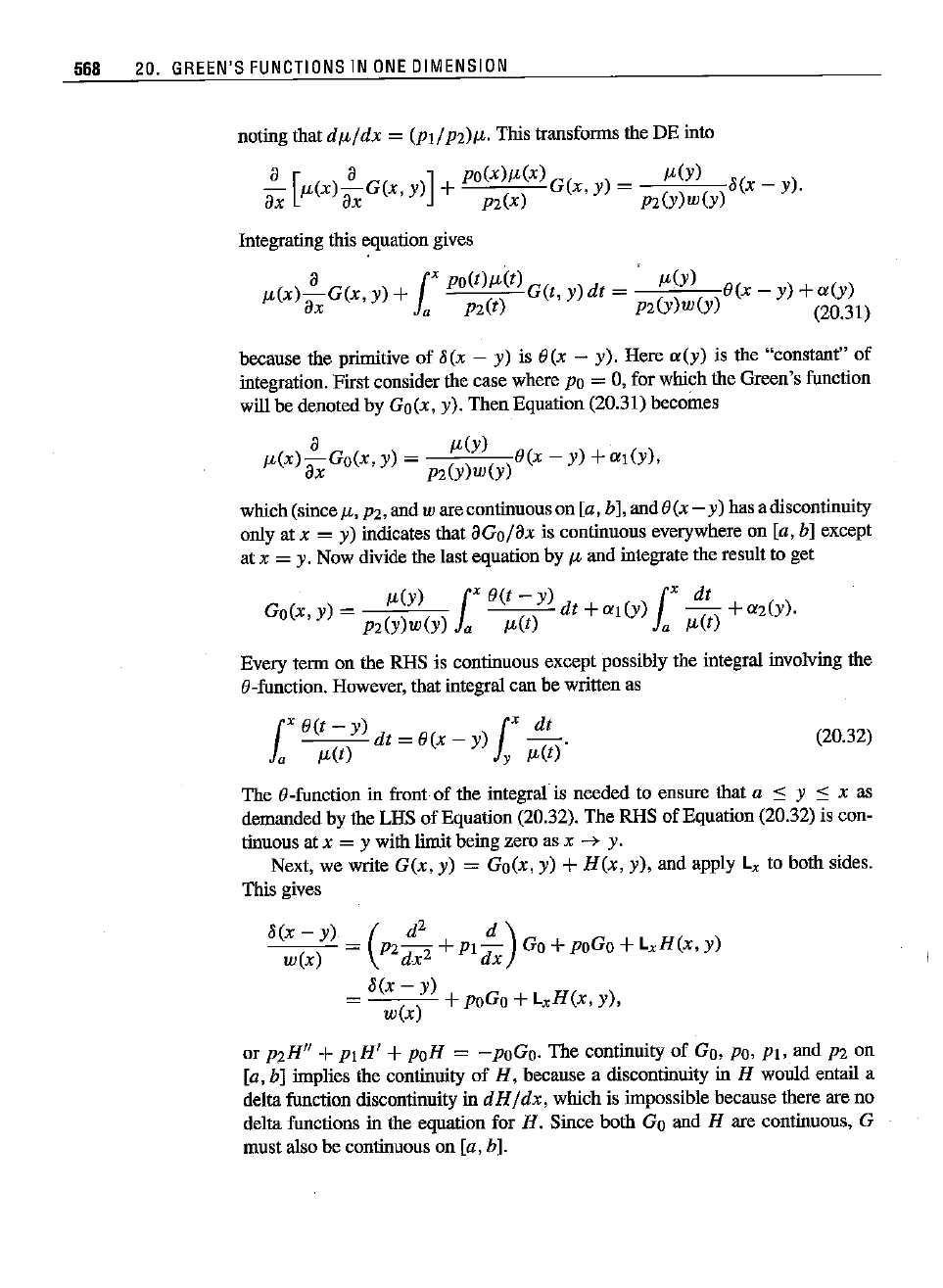
568 20.
GREEN'S
FUNCTIONS
IN
ONE
OIMENSION
notingthatdfL/dx
= (PI/P2)fL. This transforms the DE into
a [ a ] PO(X)fL(x) fL(Y)
ax fL(X) ax
G(x,
y) + P2(X)
G(x,
y) = P2(Y)W(Y)
8(x
- y).
Integrating this equation gives
a 1
x
Po(t)fL(t) , fL(Y)
fL(X)ijG(x,y)
+
()
G(t,y)dt=
()
()O(x-y)+a(y)
x a P2 t P2 y w Y (20.31)
because the primitive of 8(x - y) is O(x - y). Here
a(y)
is the "constant"
of
integration. First consider the case where Po = 0, for which the Green's function
will be denoted by
Go(x,
y). Then Eqnation (20.31) becomes
fL(X)aa
Go(x,y)
=
(;y)(
)O(x - y)
+aj(y),
x
P2YWY
which(since
u,
P2,and w are continuouson [a, b],
andO(x-y)
has adiscontinuity
only at
x = y) indicates that
aGo/ax
is continuous everywhere on [a, b] except
at
x = y. Now divide the last equation by fL and integrate the result to get
Every term on the RHS is continuous except possibly the integral involving the
O-function. However, that integral can be written as
1
x
O(t -
y)
/,X
dt
-'-...,....:--'-dt = O(x - y)
-.
a fL(t) y fL(t)
(20.32)
The O-function in front of the integral is needed to ensure that a
~
y
~
x as
demanded by the LHS of Equation (20.32). The RHS of Equation (20.32) is con-
tinuous at
x = y with limit being zero as x
-+
y.
Next, we write
G(x,
y) =
Go(x,
y) +
H(x,
y),
and apply
Lx
to both sides.
This gives
8(x
- y)
(d
2
d)
w(x)
= P2dx2 +PI
dx
Go +poGo +
LxH(x,
y)
8(x
- y)
=
w(x)
+poGo +
LxH(x,
y),
or
P2H"
+
P1H'
+
PoH
=
-PoGo·
The continuity
of
Go, po,
PI,
and P2 on
[a, b] implies the continuity of
H,
because a discontinuity in H wonld entail a
delta function discontinuity in dH /
dx;
which is impossible because there are no
delta functions in the equation for
H. Since both Go and H are continuous, G
must also be continuous on [a, b].
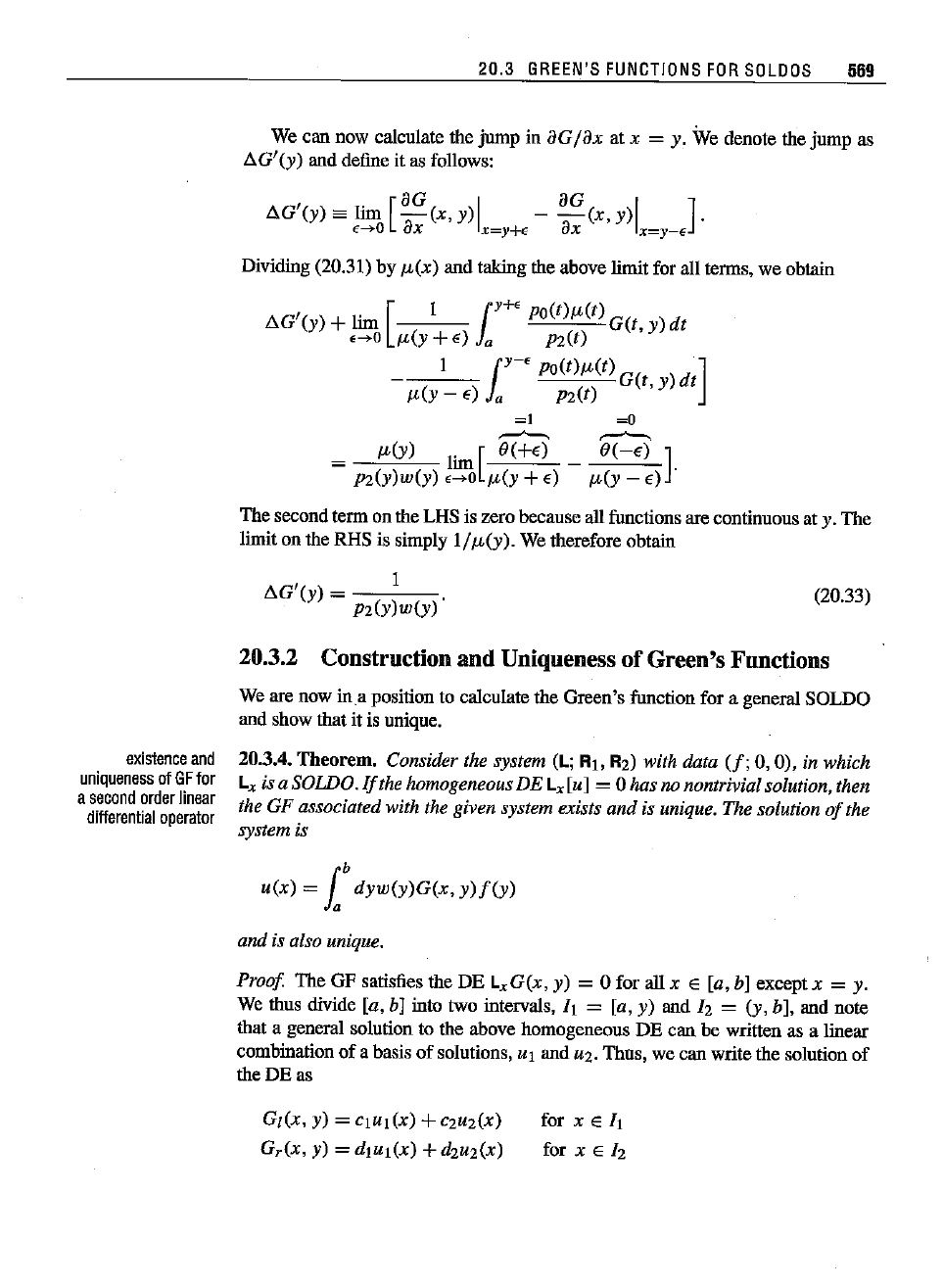
(20.33)
existence
and
uniqueness
at
GF
tor
a
second
order
linear
differential
operator
20.3
GREEN'S
FUNCTIONS
FOR
SOLOOS
569
We can now calcnlate the
jnmp
in
aG/ax
at x = y. We denote the jnmp as
A
G'
(y)
and define it as follows:
, .
[aG
I aG I ]
AG (y)
==
Inn
-(x,
y) -
-(x,
y) .
10--+0
ax
x=y+€
ax
X=y-E
Dividing (20.31) by JL(x) and taking the above limit for all terms, we obtain
AG'(y)
+lim [ I 1
Y
+' pO(t)
JL
(t)G(t, y) dt
e....0
JL(Y+f)
a
pz(t)
1 1
Y
- '
Po(t)JL(t)
G(t,
y)
dt]
JL(Y
- f) a
pz(t)
=1
~o
,-"-,
,-"-,
JL(Y)
.
[O(+f)
O(-f)]
=
pz(y)w(y)!~
JL(Y
+
f)
-
JL(Y
-
f)
.
The second term on the LHS is zero becanse all functions are continnons at y. The
limit on the RHS is simply
1/
JL(Y).
We therefore obtain
AG'
(y)
= 1
pz(y)w(y)
20.3.2 Construction and Uniqueness of Green's Fnnctions
We are now
ina
position to calcnlate the Green's function for a general SOLDO
and show that it is unique.
20.3.4.
Theorem.
Consider the system (L; RI, Rz) with data
(f;
0, 0), in which
Lx is a somo.
If
the homogeneousDE Lx[u] = 0 has nonontrivialsolution, then
the GF associated with the given system exists
and
is unique. The solution
of
the
system is
u(x)
= 1
b
dyw(y)G(x,
y)f(y)
and is also unique.
Proof
The GF satisfies the DE Lx
G(x,
y) = 0 for all x E [a, b] except x = y.
We thus divide [a, b] into two intervals, II = [a, y) and Iz =
(y,
b], and note
that a general solution to the above homogeneous DE
can
be written as a linear
combination
of
a basis
of
solutions,
Uj
and uz. Thus, we can write the solution of
the DE as
Gii», y) = CjUj(x)
+czuz(x)
Gr(x,y)
=dlul(x)+dzuz(x)
for x E II
for
x E h
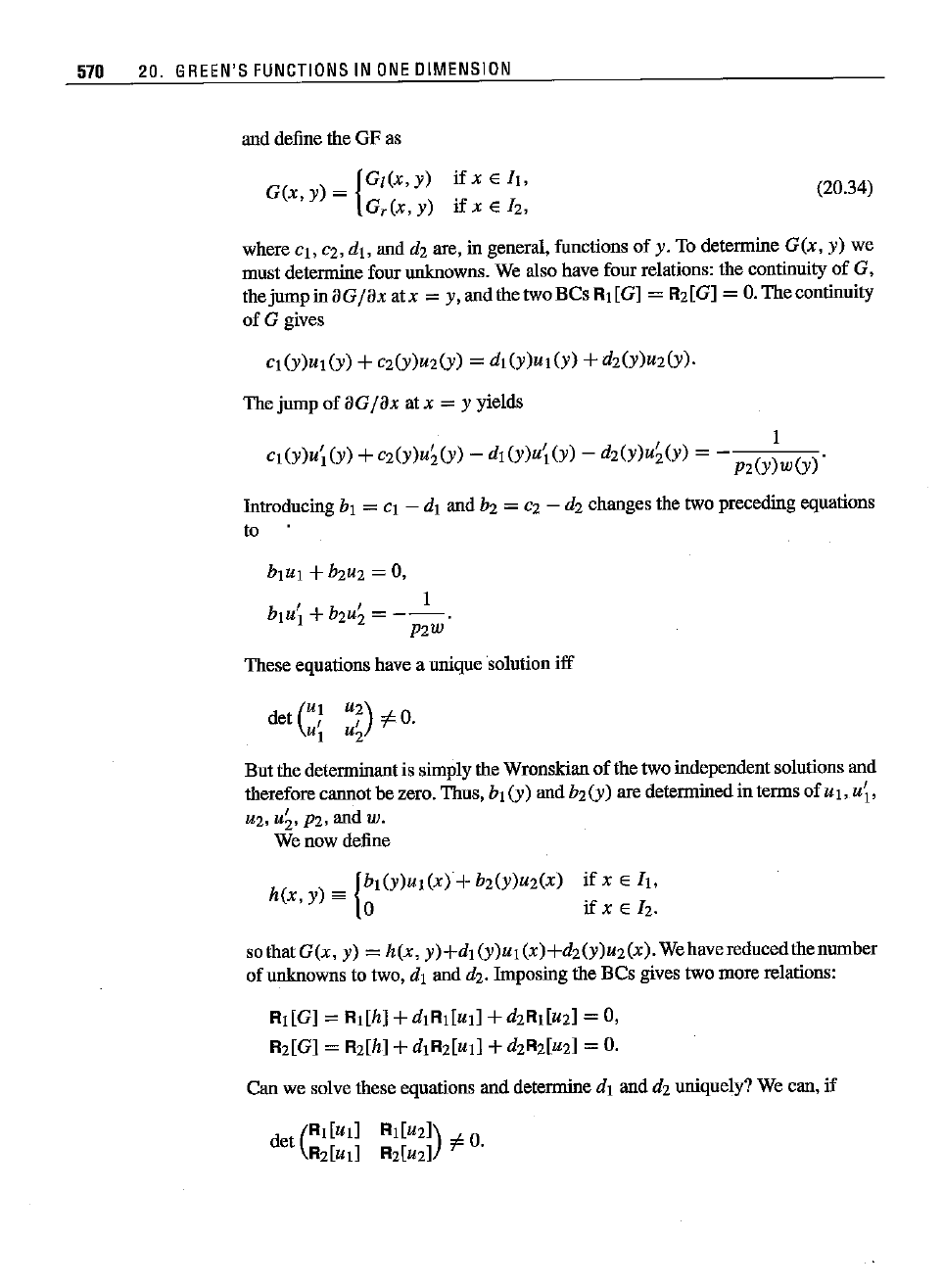
570 20.
GREEN'S
FUNCTIONS
IN
ONE
OIMENSION
and define the GF as
G(x,
y) =
{Gl(X,
y)
o,i»,
y)
ifxEII,
ifxEIz,
(20.34)
where CI,cz,
di ; and dz are, in general, functions
of
y. To determine
G(x,
y) we
must determine four unknowns. We also have fuur relations: the continuity
of
G,
the
jump
in
aGjax
atx
= y, and the two
BCs
RI[G] = Rz[G] =
O.
The
continuity
ofG
gives
The
jump
of
aGjax
atx
= y yields
I
Pz(y)w(y)
.
Introducing bl =
CJ
- dl and bz =
ci
- dz changes the two preceding equations
to
blu,
+bzuz = 0,
f f I
b,uI
+bzu
z
=
---.
pzw
These equations have a unique solution
iff
C
I
UZ)
det f f
~
O.
I U
z
But
the determinantis simply the Wronskian
of
the two independentsolutions and
therefore cannot be zero. Thus, bl
(y)
and bz(y) are determined in terms
ofu"
u\'
U2.
u;.
pz.andw.
We now define
hex, y) sa
{bOI(y)U
I
(x)+
bz(y)uz(x)
if
x E
II,
ifxE/z.
so that
G(x,
y) = hex,
y)+dl(y)u,
(x)+dz(y)uz(x).
Wehave reducedthe number
of
unknowns to two, d, and dz. Imposing the
BCs
gives two more relations:
R,[Gj
=
RI[h]
+dIR,[uiJ
+dzRI[uz]
=0,
Rz[G] = Rz[h] +
dIRz[uI]
+dzRz[uz] =
O.
Can we solve these equations and determine
dl
and dz uniquely?We can, if
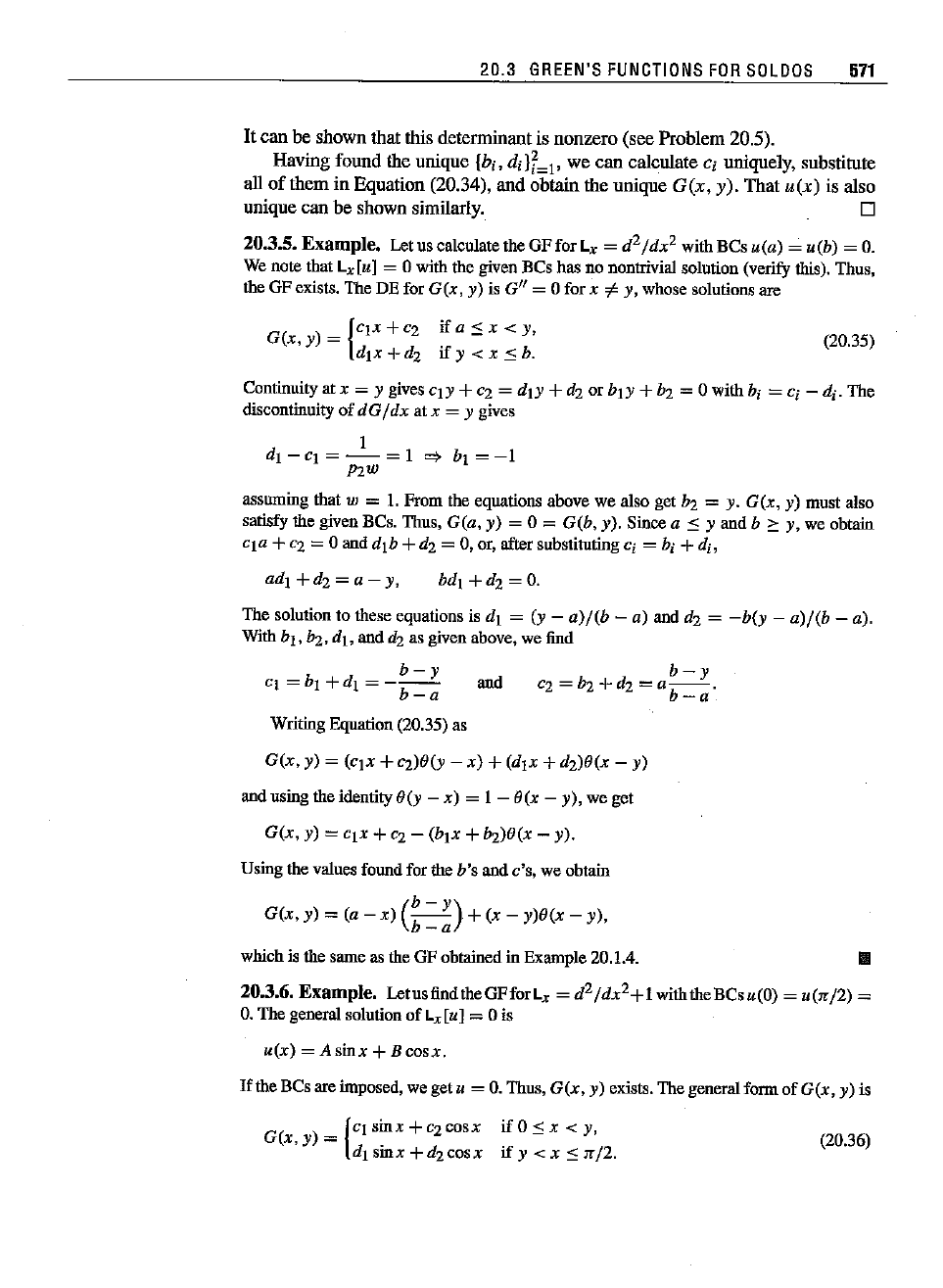
20.3
GREEN'S
FUNCTIONS
FOR
SOlDOS
571
It
can
be
shown
that this
determinant
is
nonzero
(see
Problem
20.5).
Having
found
the unique {bi,
dil~=l'
we
can
calculate ci uniquely, substitute
all
of
them
in
Equation
(20.34),
and
obtain
the
unique
G(x,
y).
That
u(x)
is also
unique
can
be shown similarly. D
20.3.5. Example. Letus calculatethe
GFfor
Lx = d
2/dx
2
with BCs u(a) = u(b) =
O.
Wenote that Lx[u] = 0 with the given BCs has no nonnivial solution (verify this). Thns,
the
GF exists.TheDEfor
G(x,
y) is G" = 0 forx
-::f.
y, whose solutions are
G(x,
y) =
{CIX
+
C2
if a
::::::
x < y,
dtx+d2
ify
<.x
s,b.
(20.35)
Continuityatx = y
givesqy
+c2
= dlY
+dz
or bj y
+bz
=Owithb
j
= Ci
-di-
The
discontinuity
of dG/ dx atx = y gives
1
dt - Cj =
--
= I
=}
bl
=-1
P2w
assuming
thatw = 1.
From
the
equations
abovewe also get
bl
= y. G(x, y) mustalso
satisfy the given BCs. Thus,
G(a, y) = 0 = G(b, y). Since a S, y and b ::: y, we obtain
CIa +
C2
=0 anddlb +dz = 0, or,
after
substituting
Ci = hi +
di,
ad
l
+d2
= a - y,
bd,
+d2
=
O.
The solution to these equations is dl = (y -
a)/(b
- a) and d2 =
-b(y
-
a)/(b
- a).
With
bl.
hz.
di.
anddzasgivenabove,we find
b-y
C2
=b2+
d2
=a-
b-·
-a
and
b-y
Cj=bl+dl=---
b-a
Writiog Equation (20.35)as
G(x,
y) = (Cjx +
C2)O(y
- x) +
(djx
+d2)O(X- y)
and using theidentity O(y - x) = 1 - O(x - y), we get
G(x,
y) = Cjx +
C2
-
(blx
+
~)O(x
- y).
Usingthevaluesfoundfortheb's andc's, we
obtain
G(x,
y) = (a - x)
(b
-
Y)
+ (x - y)O(x - y),
b-a
which is the sameas the GF obtained in Example 20.1.4.
III
20.3.6. Example. Letus findtheGFfor
Lx
= d
2
/dx
2+1
withtheBCsu(O) =
u(,,/2)
=
O.
The
general
solution ofLx[u] = 0 is
u(x)
= A sin x +
Bcosx.
!fthe
BCsareimposed, we get u =
O.
Thus,
G(x,
y) exists.The generalfonn
ofG(x,
y) is
G(x,
y) =
{CI
sinx
+
C2
cosx
if
0::::;
x < y,
dl
sinx
+d2COSX
if
Y <
x::::;
rr/2.
(20.36)

572
20.
GREEN'S
FUNCTIONS
IN
ONE
OIMENSION
Continuity
of
G at x = y gives hI sin y + b: cos y = awithhi = Ci - dj. The
discontinuity
of
the derivative
of
G at x = y gives hI cos y - b: sin Y =
-I,
where we
haveset
w(x)
= 1.Solvingthese
equations
yields hI = - cosy and
~
= siny. The
Bes
give
G(O,y)=O
~
c2=0
~
dz=-b2=-siny,
G(rr/2,y)=0
~
d,=O
~
q=-b,=-cosy.
Substituting in Equatioo(20.36)gives
G(
{
- COSY S
in
X if x -c y,
x,y)
= .
-smycosx
if y .c x,
or,
usingthetheta
function,
G(x,
y) =
-O(y
-
x)
cosy sinx - O(y -
x)
siny cosx
=
-[I
- O(x -
y)]
cosYsinx - O(x - y) siny cosx
=
-cosy
sinx +O(x -
y)
sin(x - y).
It
is instructiveto verifydirectlythat
G(x,
y) satisfies
Lx[G]
=
~(x
- y):
Lx[G]
=
-cosy
(~+,)
sinx +
(::z
+
I)
[O(x - y) sin(x -
y)]
~O
d
Z
=
dx
2
[O(x - y)
sin(x -
y)]
+O(x - y) sin(x - y)
=
~[~(x
- y) sin(x - y)
+O(x
- y) cos(x -
y)]
+O(x - y) sin(x - y).
dx •
~O
The
first
term
vanishes
because
the
sinevanishes attheonlypointwherethedelta
function
is
nonzero.
Thus,we have
Lx[G]
=
[~(x
- y) cos(x - y) - O(x - y) sin(x -
y)]
+O(x - y) sin(x - y)
=8(x - y)
becausethedeltafunctiondemandsthat x = y, for whichcos(x - y) = I.
The
existence and nniqueness
of
the Green's function
G(x,
y) in conjnnction
withits propertiesand its adjoint, implythe existenceand uniqueness
of
the adjoint
Green's function
g(x,
y). Using this fact, we
can
show that the condition for the
absence
of
a nontrivial solution for Lxlu] = 0 is also a necessary condition for
the existence
of
G(x,
y).
That
is,
if
G(x,
y) exists, then Lxlu] = 0 implies that
u = O. Suppose
G(x,
y) exists; then
g(x,
y) also exists. In Green's identity let
v =
g(x,
y). This gives an identity:
l
b
w(x)g*(x,
y)(Lxlu]) dx = l
b
w(x)u(x)(Lllg])*
dx
l
b
8(x - y)
=
w(x)u(x)
dx =
u(y).
a
w(x)
